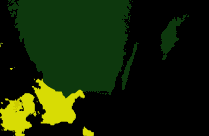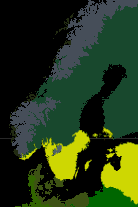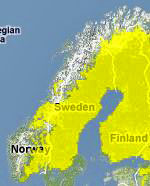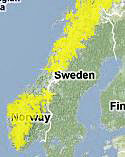Sweden (Ecoregions of Sweden)
Contents
Ecoregions of Sweden
The ecoregions of Sweden consist of several types of terrestrial ecological systems, the chief of which are:
- Baltic mixed forests present a coastal plain of level topography with low pH soils that support mixed forests of beech and oak. Inland, the flora transitions to European hornbeam, Scots pine and linden canopy.
- Sarmatic mixed forests consist of a mixed conifer-broadleaf plant association dominated by Norway Spruce and Scots Pine
- Scandinavian and Russian taiga is an ecoregion within the boreal forests/taiga zone
- Scandinavian montane birch forests and grasslands includes extensive unvegetated areas as well as dwarf birch forests
In addition to these major ecoregions, one highly specialized area deserves mention: the limestone pavement ecosystem on the island of Oland, off of the southeastern coast of Sweden. This low lying island supports a large number of endemic flora, due to its specialized alvar soils and separation from the mainland.
Baltic mixed forests
 Baltic mixed forests (in yellow). Source: World Wildlife Fund
Baltic mixed forests (in yellow). Source: World Wildlife Fund
In Sweden the Baltic mixed forests occupy a very small area in the extreme south of Sweden rimmed by the Baltic Sea. This ecoregion is within a temperate zone much farther north than comparable areas in the western part of the Eurasian continent or compared eastern North America. Comprised of both forests and wetlands, the Baltic mixed forests ecoregion displays many different habitats and, accordingly, a broad diversity of species. Migrating and breeding water-birds, shorebirds, and wading birds visit this habitat each year, such that 32 Important Bird Areas have been designated within the ecoregion as a whole. Directly north of this ecoregion in Sweden lies the Sarmatic mixed forests.
Sarmatic mixed forests
 Sarmatic mixed forests (in yellow) occupy much of
Sarmatic mixed forests (in yellow) occupy much of
southern Sweden. Source: World Wildlife Fund
This forest type is spread over a large area of northern Europe and the Ural area of Russia; more specifically this forest type is found particularly in Scandinavia, the Baltics and the Ural area of Russia. Typically, Sarmatic mixed makes a transition into boreal taiga at their northern limit and mixed broadleaf forests at their southern limit [1]. In Sweden these forests include certain areas of lowland to submontane hemiboreal and nemoral pine forests.[2] The sarmatic mixed forests are comprised of a mixed conifer broadleaf plant association dominated by Norway Spruce (Picea abies) and Scots Pine (pinus sylvestris) with some broadleaf admixture (particularly oak species in the north). Sarmatic mixed forests are given the World Wildlife Fund (WWF) designation PA0436. Immediately north of the Sarmatic mixed forests in Sweden is positioned the Scandinavian and Russian taiga ecoregion.
In addition to the dominant canopy—Scots pine and Norway spruce intermixed with some broadleaf species—there are numerous shrubs, forbs, grasses and mosses that inhabit the mid-tier and forest floor. Common low-growing shrubs include Bilberry (Vaccinium myrtillus) and Heather (Calluna vulgaris).
Example wildflowers or forbs seen in the forest understory include Common Spotted Orchid (Dactylorhiza fuchsii), Red Campion (Silene dioica), White Campion (Silene latifolia ssp. alba), Sand Catchfly (Silene conica), Field Scabious (Knautia arvensis) and Marsh Helleborine (Epipactis palustris). In some fens within forest clearings the Marsh thistle (Cirsium palustre) is found.
 Scandinavian & Russian taiga. WWF This ecoregion spreads across a wide expanse of landscape in Scandinavia and northern Russia within the boreal forests/taiga zone. It consists of coniferous forests dominated by Scots Pine in the drier locales), frequently with an understory of Common Juniper (Juniperus communis) and Norway Spruce, along with a significant admixture of White Birch (Betula pubescens) and Silver Birch (Betula pendula). Scandinavian and Russian taiga covers more land area than any other of Sweden's ecoregions, and is designated as ecoregion PA0608 by the WWF.
Scandinavian & Russian taiga. WWF This ecoregion spreads across a wide expanse of landscape in Scandinavia and northern Russia within the boreal forests/taiga zone. It consists of coniferous forests dominated by Scots Pine in the drier locales), frequently with an understory of Common Juniper (Juniperus communis) and Norway Spruce, along with a significant admixture of White Birch (Betula pubescens) and Silver Birch (Betula pendula). Scandinavian and Russian taiga covers more land area than any other of Sweden's ecoregions, and is designated as ecoregion PA0608 by the WWF.
This ecoregion covers a large percentage of the European continent, with tundra at the north and temperate mixed forests to the south. Only a limited number of coniferous tree species, including pine and juniper, and a few broadleaf trees, including birches and willows, thrive within these taiga forests, with species diversity increasing in the south with maple, linden, ash and oak trees. Characteristic herbaceous plants include sedge, stiff club moss, May lily, twinflower, heart-leaved tway blade, shinleaf, lesser rattlesnake plantain and ground pine. The ecoregion to the north of the Scandinavian and Russian taiga is the Scandinavian montane birch forests and grasslands.
 Scandinavian montane birch forests
Scandinavian montane birch forests
and grasslands.WWF
The ecoregion follows the Scandinavian Mountains, and the ecoregion as a whole continues into Norway and Finland. Some of the largest glaciers on the European mainland are located within the Scandinavian montane birch forests and grasslands ecoregion, as well as the highest peaks and the largest mountain plateau in northern Europe. The mountain chain itself creates a rainshadow. This stark ecoregion has extensive sparsely vegetated high alpine tundra areas, dominated by bare rock, skrees, snowfields and glaciers; other areas consist of low alpine tundra covered by Dwarf Birch (Betula nana) admixed with willow of up to one metre in height; this low tundra has patches of grassland, bogs and lakes.
The balance of this ecoregion consists of a landscape similar to the adjacent montane birch zone with two to five metre high mountain downy birch (Betula pubescens) stands estending above the conifer treeline; some stunted Norway spruce and Scots pine are also noted here, and numerous bogs and lakes are present. This part is regarded as part of the North Boreal vegetation zone In the lower elevations, the forests being closed-canopy and generally relate to the Scandinavian and Russian taiga ecoregion, This entire ecoregion is designated by the WWF as PA 1110,
Structural context of ecoregions
Ecoregions are areas that: [1] share a large majority of their species and ecological dynamics; [2] share similar environmental conditions; and, [3] interact ecologically in ways that are critical for their long-term persistence. Scientists at the World Wildlife Fund, have established a classification system that divides the world in 867 terrestrial ecoregions, 426 freshwater ecoregions and 229 marine ecoregions that reflect the distribution of a broad range of fauna and flora across the Earth.
